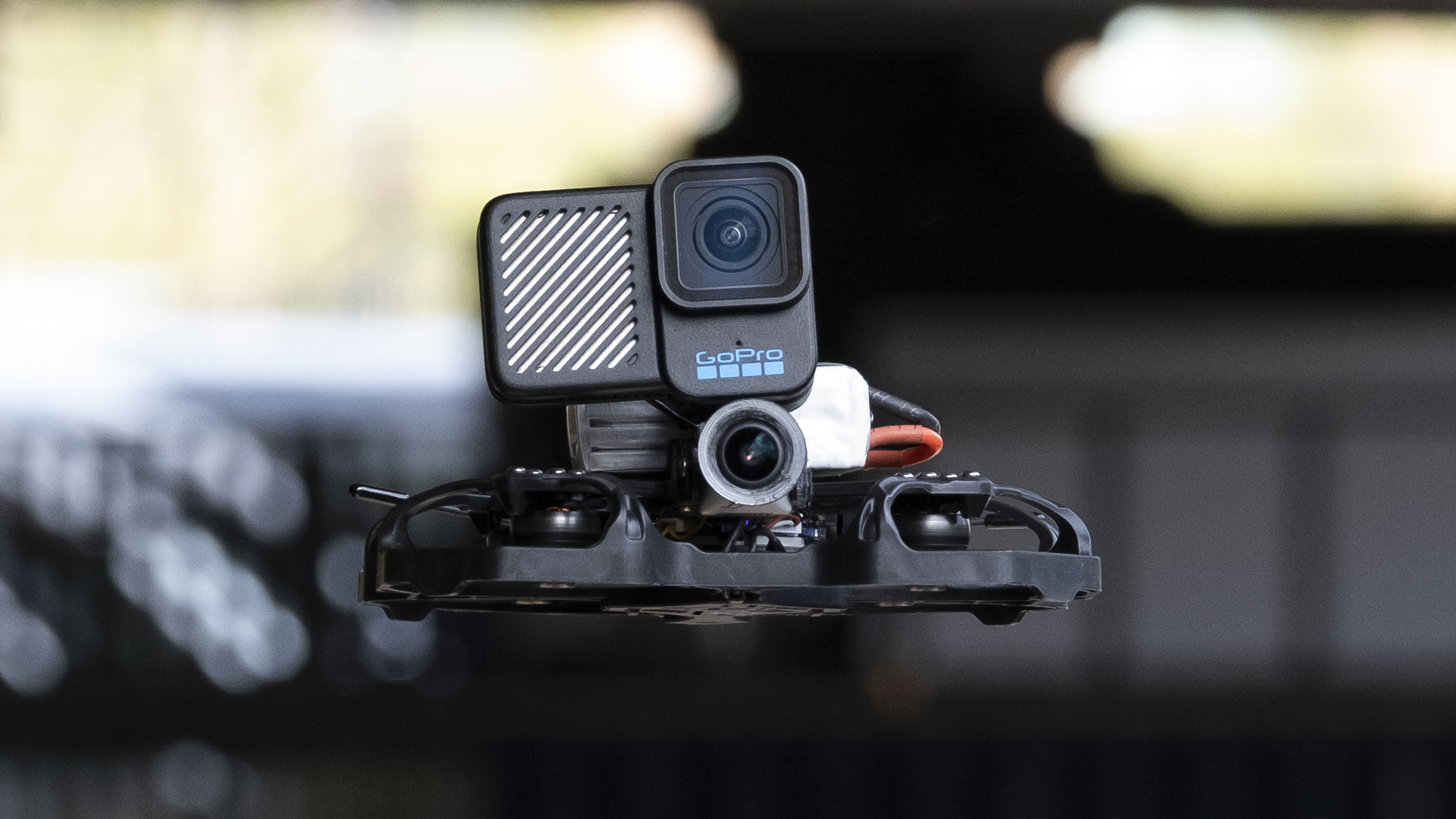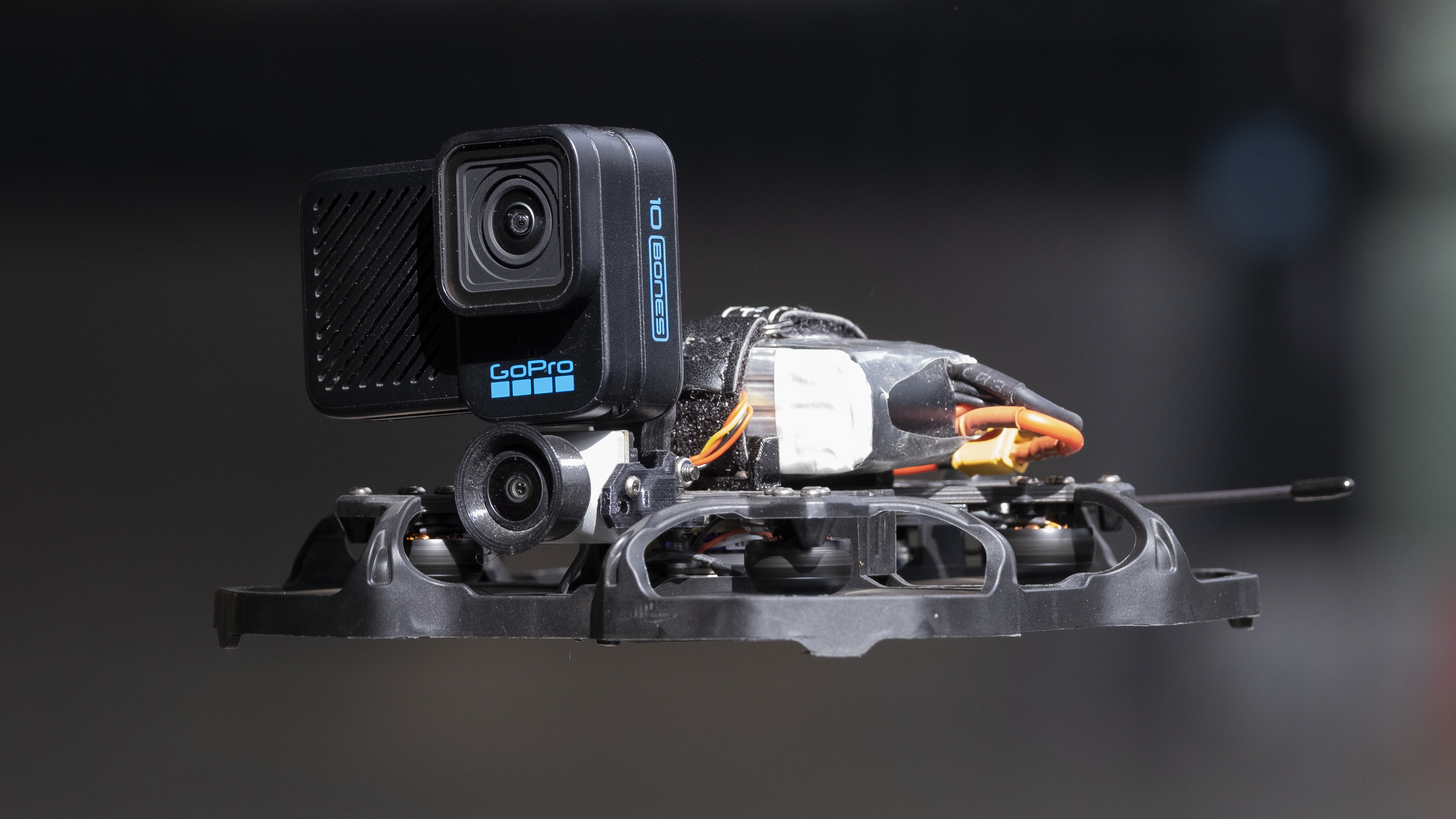GoPro’s FPV drone camera is the start of its new age of anti-Heros

GoPro's discontinued Karma drone had such a bad take-off in 2016 that you'd forgive its cameras for never wanting to fly again. But its new Hero for FPV (first-person view) drones reveals a more sensible, laser-focused approach that should help banish those ghosts – and gives us an intriguing glimpse of what other Hero cameras to expect this year.
The Hero 10 Black Bones is the really anti-Karma. Rather jumping outside its comfort zone and building a drone with an unfortunate tendency to lose power mid-flight, GoPro has instead stripped down its flagship action cam and made what looks like the perfect little camera for FPV fans. You can see why in our hands-on GoPro Hero 10 Black Bones review.
When it comes to product launches, this is about as close to a guaranteed home run as you can get. Yes, FPV drones are still pretty niche, but a significant number of pilots have been reverse-engineering Hero action cameras to make them suitable for small drones for years. The growing community has also frequently pleaded with GoPro to make a newer version of its previous tiny action cam, the Hero Session (which arrived back in 2015).

Well, the Hero 10 Black Bones is that camera. And that means we can expect to see a lot more videos like Tesla's swooping Gigafactory tour. The only real downsides are that Bones is currently US-only, with GoPro telling us "we do not have a date yet for international availability". And the fact that it's strangely more expensive than the Hero 10 Black, despite that fact that 'Bones' lacks the display, battery, speaker, GPS, or waterproof build quality of its all-rounder sibling.
When we asked GoPro about this, it told us its new action cam costs "significantly less than the industry going rate for a “naked” GoPro, and Bones helps you save time, money and risk by delivering a quality product with GoPro warranty". Perhaps, but there's no doubt GoPro is cashing in on the unique combination of Bones and the ReelSteady stabilization software it acquired in 2020, which only works with GoPro gyro data. And that's a sign of things to come.
Skeleton crew
Naturally, we'd rather the GoPro Hero 10 Black Bones was priced more like the Hero 4 Session, which quickly dropped to $199 from its original $399 price tag. But this strategy, which seems more likely to succeed than the all-in-one DJI FPV, reflects a new, savvier GoPro that sees niche, specialist cameras as the fix for plateauing demand for its do-it-all Hero range.
So where else might GoPro take the 'Bones' approach? A strong contender, based on some patent applications we recently discovered, is a rival to the DJI Pocket 2 vlogging camera. The patent applications describe a Session-style modular camera that would, unusually for GoPro, sit in a three-axis mechanical gimbal for super-smooth stabilization. This marks it out from the recent GoPro Volta grip accessory.
Sign up for breaking news, reviews, opinion, top tech deals, and more.
Interestingly, the camera is also described as modular and compatible with drones. Could the Hero 10 Black Bones have already given us a glimpse of GoPro's vlogging camera? If so, the move would again have echoes its Karma drone, whose camera could be removed and used with the now-discontinued Karma grip stabilizer.

The possibilities for specialist GoPro cameras don't end there either: a dash cam, streaming camera, bike camera and, in particular, high-end professional GoPro are also surely on the cards. One of our few issues with the Hero 10 Black Bones is that it still only lets you shoot with 8-bit color depth – which means there could well be room for a higher-end Hero, offering features like 10-bit color depth, in the near future.
While we're moving into the realms of speculation here, it does have a solid grounding – a recent earnings call confirmed that this kind of specialization is going to be GoPro's direction for the next couple of years. During the call in February, GoPro CEO Nick Woodman said that "at the end of 2022, we plan to increase our hardware offering from the two product types we have today, Hero and Max, to four distinct camera products".
Is the Hero 10 Black Bones one of those four products? Given it's part of the Hero line, perhaps not – and that apparently won't be the end of GoPro's expansion. According to Woodman, GoPro "expects to expand that further by the end of 2023". In other words, 'Bones' is just an appetizer for what's to come from the action cam maker.
Karma chameleon
This is change of tack is long overdue. GoPro has taken a long time to recover from the hedonistic mid-2010s when it over-extended itself with launches like the Karma drone.
This set the company on a more focused path that led to the Hero 9 Black, Hero 10 Black and, importantly, a new software-focused model that's produced some popular wins. These include the GoPro Quik app, the new GoPro Player + ReelSteady desktop app, and its GoPro Subscription, which we rate as a good investment (particularly if you're planning to buy one of its cameras).

The upshot of all this is that GoPro is ready to make some interesting new cameras again, if not like the ones of the past. The Hero 10 Black Bones is an interesting start, but it's just a hint of the ways GoPro is planning to chop up its all-in-one action cam into smaller, and perhaps more useful, pieces.
Smartphones may mean that GoPros will never again reach the heights of their earlier mainstream appeal, but in its 20th year it seems the action cam king is preparing to show off its new tricks – and we're looking forward to seeing what those are later this year.

Mark is TechRadar's Senior news editor. Having worked in tech journalism for a ludicrous 17 years, Mark is now attempting to break the world record for the number of camera bags hoarded by one person. He was previously Cameras Editor at both TechRadar and Trusted Reviews, Acting editor on Stuff.tv, as well as Features editor and Reviews editor on Stuff magazine. As a freelancer, he's contributed to titles including The Sunday Times, FourFourTwo and Arena. And in a former life, he also won The Daily Telegraph's Young Sportswriter of the Year. But that was before he discovered the strange joys of getting up at 4am for a photo shoot in London's Square Mile.